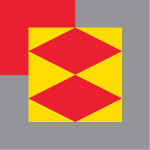Railfreight Distribution
Railfreight Distribution was a sub-sector of British Rail created by the division in 1987 of British Rail's previous Railfreight sector. It was responsible for non-trainload freight operations, as well as Freightliner and Intermodal services. In its early years the division was occasionally referred to as Speedlink Distribution. It was later responsible for freight operations through the Channel Tunnel.
 | |
| State owned | |
| Industry | Rail freight |
| Fate | Split into regional sectors for privatisation |
| Successor | 1995: Freightliner (Intermodal) 1996: English Welsh & Scottish (Wagonload) |
| Founded | 1987 |
| Defunct | 1995 |
| Headquarters | |
| Services | Intermodal and Wagonload freight |
| Parent | British Rail |
| Divisions | Speedlink (Wagonload) and Freightliner (Intermodal) |
Division and sale
With the privatisation of British Rail, the intermodal business was split off in 1995 to form a separate company called Freightliner. In 1997, Railfreight Distribution was bought by English Welsh & Scottish.[1]
Locomotives
By the end, the fleet included several Class 47s, a group of Class 86s, a single Class 87 (87101), a fleet of Class 90s, and Class 92s, most of which were in store awaiting acceptance. Some of these were owned by European Passenger Services and SNCF and these were operated as a common user pool. The fleet was primarily based at Tinsley and Crewe Electric Depots at the time of privatisation, although many other depots were utilised during Railfreight Distribution's existence, mainly for shunting locomotives.
Liveries
In 1987, it introduced a new livery of two tone grey similar to those adopted by the Trainload Freight and Railfreight General sub-sectors, with a logo consisting of two red diamonds on a yellow background offset on top of a red square. In 1992 in anticipation of the opening of the Channel Tunnel, the livery was revised to the 'European' version with a dark grey upper bodyside, a light grey lower bodyside, a blue coloured roof and 'Railfreight Distribution' lettering on the bodyside. Also in 1992, three Class 90/1s, (90128, 90129 and 90130), were given "continental" liveries of NMBS/SNCB blue, Deutsche Bahn red and SNCF grey to mark the Freightconnection Conference, each loco was named "Freightconnection" in the livery's appropriate language. These three Class 90s were later reverted to their original 90/0 configuration
References
Further reading
- Dunn, Pip (22 October – 4 November 1997). "RfD's Driving Ambition". RAIL. No. 316. EMAP Apex Publications. pp. 20–23. ISSN 0953-4563. OCLC 49953699.
- "Good-bye Railfreight Distribution". RAIL. No. 346. EMAP Apex Publications. 16–29 December 1998. p. 14. ISSN 0953-4563. OCLC 49953699.